BUACC5933: Cost and Management Accounting Essay, Sem 1, 2019
VerifiedAdded on 2023/03/17
|13
|3556
|33
Essay
AI Summary
This essay delves into the relevance of traditional budgeting and standard costing in the contemporary business environment. It begins by introducing the challenges organizations face due to changing conditions and technologies, emphasizing the importance of effective financial resource management through planning and controlling, with budgeting as a key strategy. The essay then assesses traditional budgeting, examining its strengths, such as planning and coordination, and weaknesses, including being time-consuming and potentially rigid. It also explores the significance of budgeting in modern businesses, highlighting its role in performance assessment, communication, and control. The essay further discusses the significance of traditional budgeting and alternative budgeting processes. The essay then shifts its focus to standard costing, comparing it with activity-based costing and assessing its relevance. It examines the benefits and limitations of standard costing and its continued use in various industries. The essay concludes by emphasizing the importance of adapting to the dynamics of modern business while understanding the value of traditional costing methods.
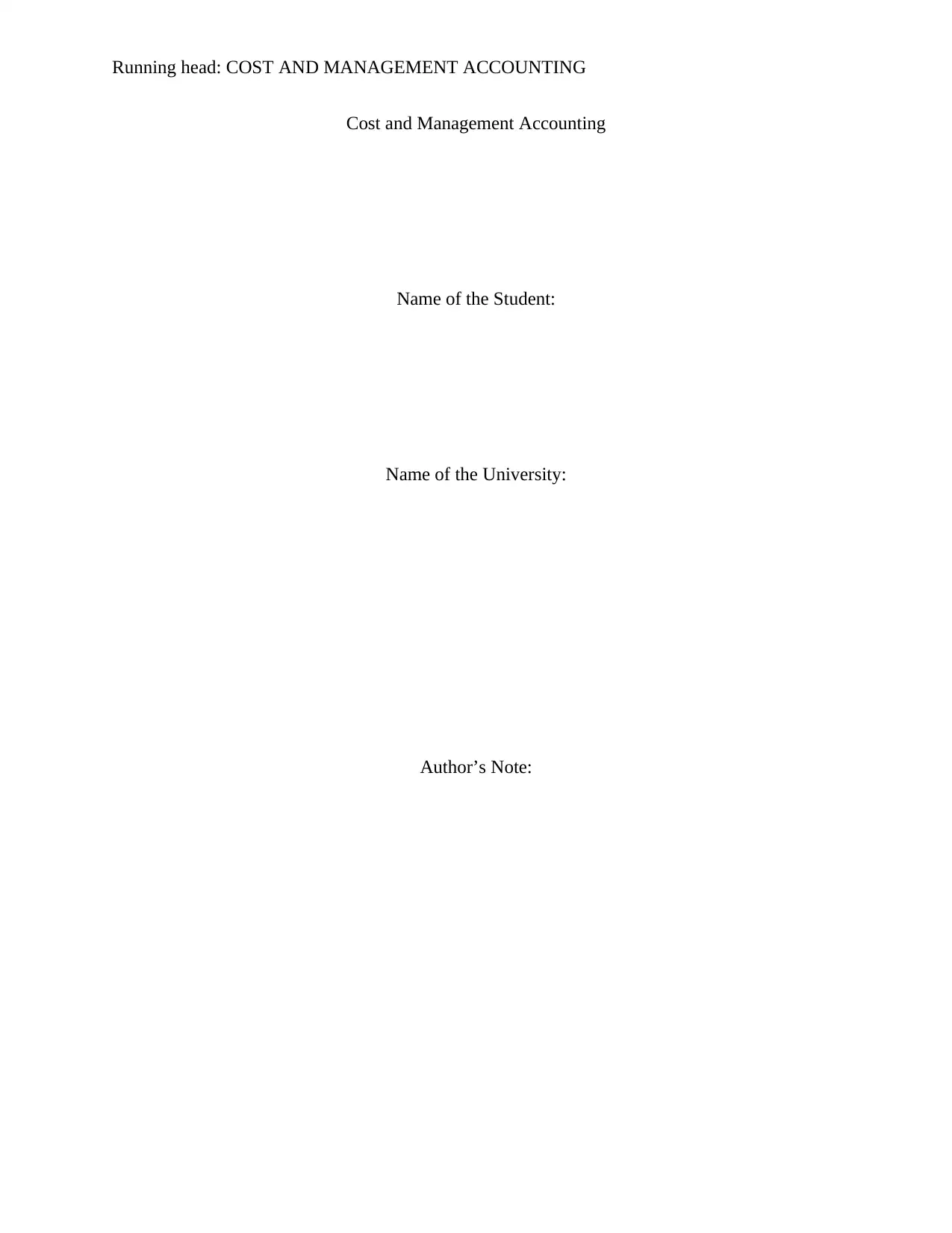
Running head: COST AND MANAGEMENT ACCOUNTING
Cost and Management Accounting
Name of the Student:
Name of the University:
Author’s Note:
Cost and Management Accounting
Name of the Student:
Name of the University:
Author’s Note:
Paraphrase This Document
Need a fresh take? Get an instant paraphrase of this document with our AI Paraphraser
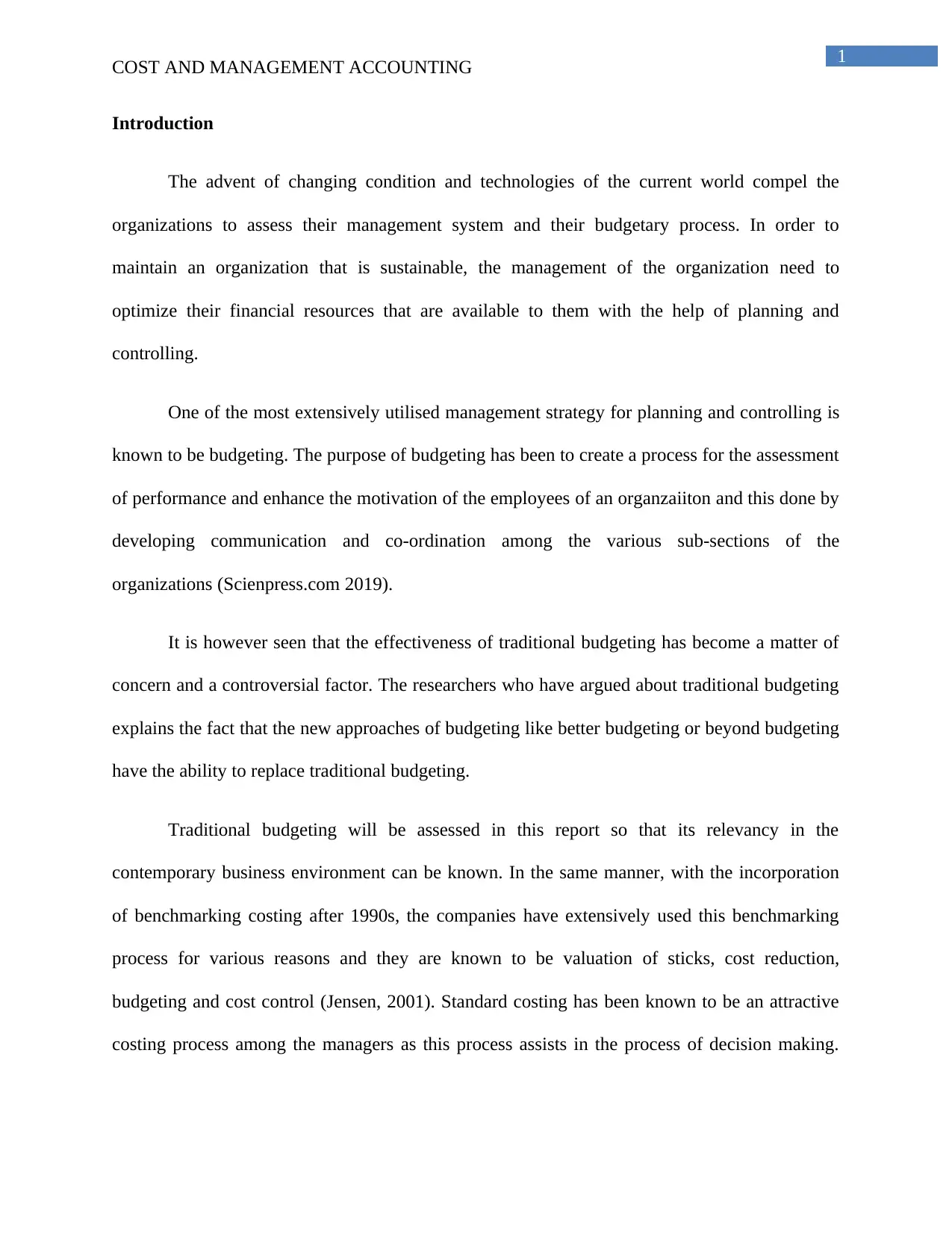
1
COST AND MANAGEMENT ACCOUNTING
Introduction
The advent of changing condition and technologies of the current world compel the
organizations to assess their management system and their budgetary process. In order to
maintain an organization that is sustainable, the management of the organization need to
optimize their financial resources that are available to them with the help of planning and
controlling.
One of the most extensively utilised management strategy for planning and controlling is
known to be budgeting. The purpose of budgeting has been to create a process for the assessment
of performance and enhance the motivation of the employees of an organzaiiton and this done by
developing communication and co-ordination among the various sub-sections of the
organizations (Scienpress.com 2019).
It is however seen that the effectiveness of traditional budgeting has become a matter of
concern and a controversial factor. The researchers who have argued about traditional budgeting
explains the fact that the new approaches of budgeting like better budgeting or beyond budgeting
have the ability to replace traditional budgeting.
Traditional budgeting will be assessed in this report so that its relevancy in the
contemporary business environment can be known. In the same manner, with the incorporation
of benchmarking costing after 1990s, the companies have extensively used this benchmarking
process for various reasons and they are known to be valuation of sticks, cost reduction,
budgeting and cost control (Jensen, 2001). Standard costing has been known to be an attractive
costing process among the managers as this process assists in the process of decision making.
COST AND MANAGEMENT ACCOUNTING
Introduction
The advent of changing condition and technologies of the current world compel the
organizations to assess their management system and their budgetary process. In order to
maintain an organization that is sustainable, the management of the organization need to
optimize their financial resources that are available to them with the help of planning and
controlling.
One of the most extensively utilised management strategy for planning and controlling is
known to be budgeting. The purpose of budgeting has been to create a process for the assessment
of performance and enhance the motivation of the employees of an organzaiiton and this done by
developing communication and co-ordination among the various sub-sections of the
organizations (Scienpress.com 2019).
It is however seen that the effectiveness of traditional budgeting has become a matter of
concern and a controversial factor. The researchers who have argued about traditional budgeting
explains the fact that the new approaches of budgeting like better budgeting or beyond budgeting
have the ability to replace traditional budgeting.
Traditional budgeting will be assessed in this report so that its relevancy in the
contemporary business environment can be known. In the same manner, with the incorporation
of benchmarking costing after 1990s, the companies have extensively used this benchmarking
process for various reasons and they are known to be valuation of sticks, cost reduction,
budgeting and cost control (Jensen, 2001). Standard costing has been known to be an attractive
costing process among the managers as this process assists in the process of decision making.
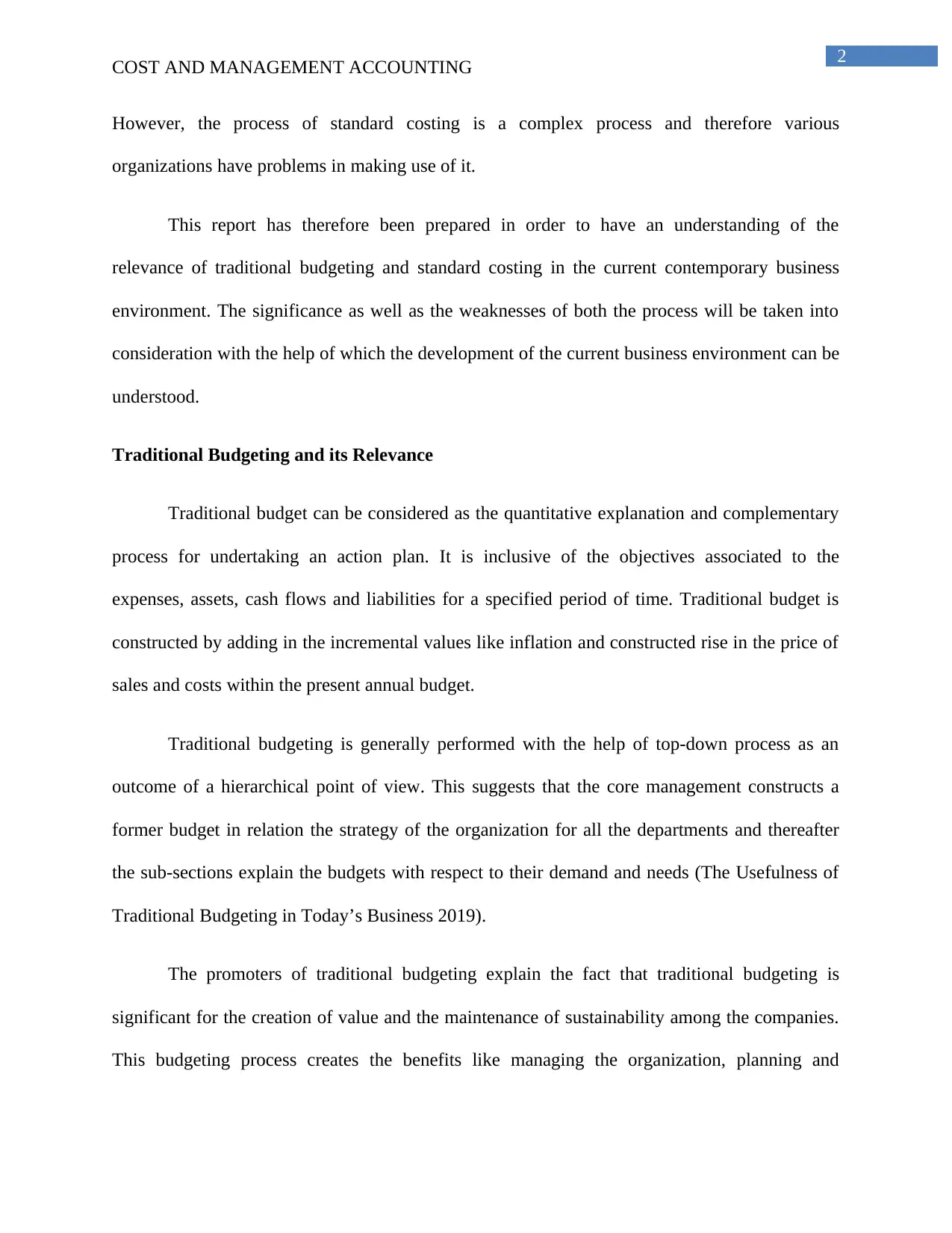
2
COST AND MANAGEMENT ACCOUNTING
However, the process of standard costing is a complex process and therefore various
organizations have problems in making use of it.
This report has therefore been prepared in order to have an understanding of the
relevance of traditional budgeting and standard costing in the current contemporary business
environment. The significance as well as the weaknesses of both the process will be taken into
consideration with the help of which the development of the current business environment can be
understood.
Traditional Budgeting and its Relevance
Traditional budget can be considered as the quantitative explanation and complementary
process for undertaking an action plan. It is inclusive of the objectives associated to the
expenses, assets, cash flows and liabilities for a specified period of time. Traditional budget is
constructed by adding in the incremental values like inflation and constructed rise in the price of
sales and costs within the present annual budget.
Traditional budgeting is generally performed with the help of top-down process as an
outcome of a hierarchical point of view. This suggests that the core management constructs a
former budget in relation the strategy of the organization for all the departments and thereafter
the sub-sections explain the budgets with respect to their demand and needs (The Usefulness of
Traditional Budgeting in Today’s Business 2019).
The promoters of traditional budgeting explain the fact that traditional budgeting is
significant for the creation of value and the maintenance of sustainability among the companies.
This budgeting process creates the benefits like managing the organization, planning and
COST AND MANAGEMENT ACCOUNTING
However, the process of standard costing is a complex process and therefore various
organizations have problems in making use of it.
This report has therefore been prepared in order to have an understanding of the
relevance of traditional budgeting and standard costing in the current contemporary business
environment. The significance as well as the weaknesses of both the process will be taken into
consideration with the help of which the development of the current business environment can be
understood.
Traditional Budgeting and its Relevance
Traditional budget can be considered as the quantitative explanation and complementary
process for undertaking an action plan. It is inclusive of the objectives associated to the
expenses, assets, cash flows and liabilities for a specified period of time. Traditional budget is
constructed by adding in the incremental values like inflation and constructed rise in the price of
sales and costs within the present annual budget.
Traditional budgeting is generally performed with the help of top-down process as an
outcome of a hierarchical point of view. This suggests that the core management constructs a
former budget in relation the strategy of the organization for all the departments and thereafter
the sub-sections explain the budgets with respect to their demand and needs (The Usefulness of
Traditional Budgeting in Today’s Business 2019).
The promoters of traditional budgeting explain the fact that traditional budgeting is
significant for the creation of value and the maintenance of sustainability among the companies.
This budgeting process creates the benefits like managing the organization, planning and
⊘ This is a preview!⊘
Do you want full access?
Subscribe today to unlock all pages.

Trusted by 1+ million students worldwide
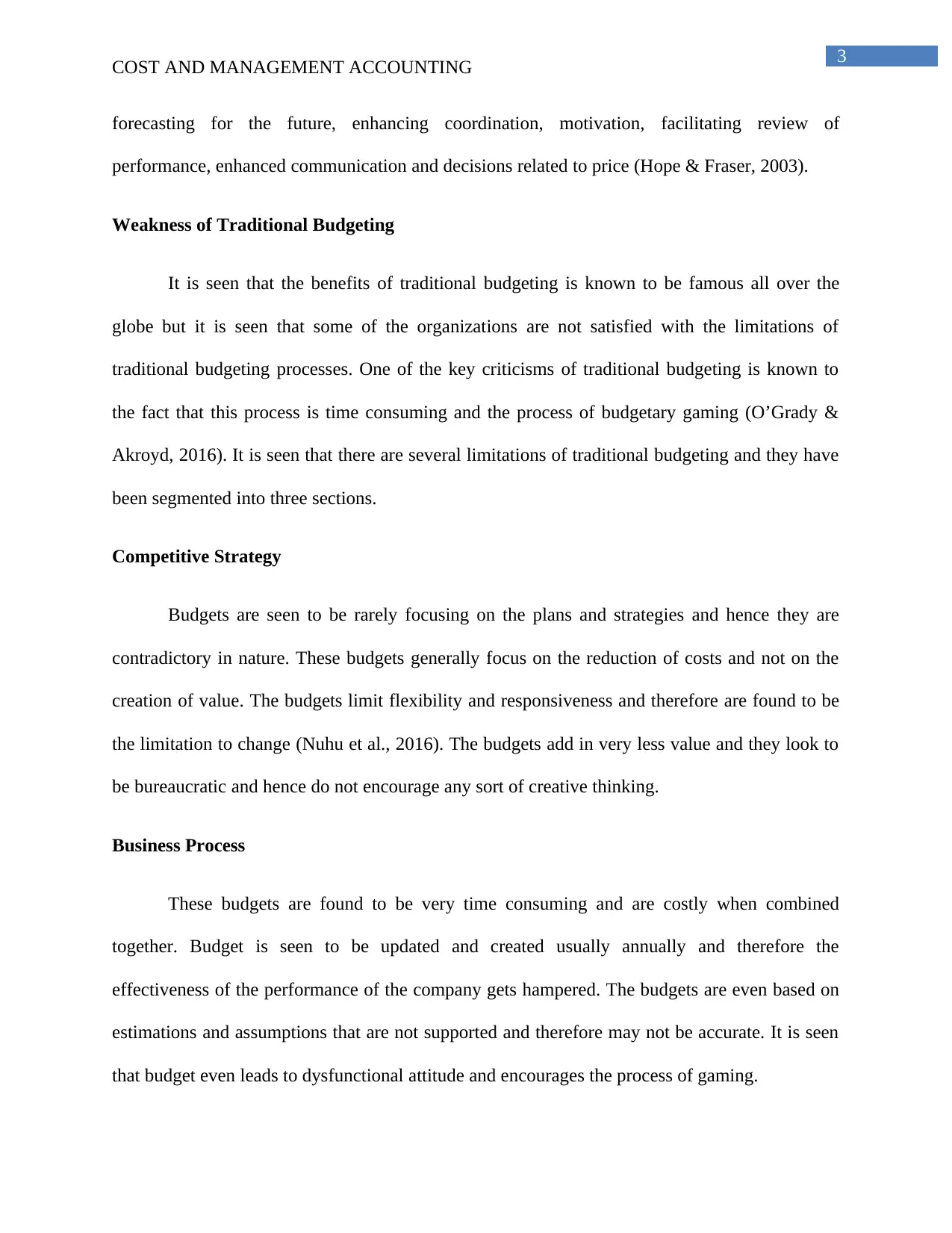
3
COST AND MANAGEMENT ACCOUNTING
forecasting for the future, enhancing coordination, motivation, facilitating review of
performance, enhanced communication and decisions related to price (Hope & Fraser, 2003).
Weakness of Traditional Budgeting
It is seen that the benefits of traditional budgeting is known to be famous all over the
globe but it is seen that some of the organizations are not satisfied with the limitations of
traditional budgeting processes. One of the key criticisms of traditional budgeting is known to
the fact that this process is time consuming and the process of budgetary gaming (O’Grady &
Akroyd, 2016). It is seen that there are several limitations of traditional budgeting and they have
been segmented into three sections.
Competitive Strategy
Budgets are seen to be rarely focusing on the plans and strategies and hence they are
contradictory in nature. These budgets generally focus on the reduction of costs and not on the
creation of value. The budgets limit flexibility and responsiveness and therefore are found to be
the limitation to change (Nuhu et al., 2016). The budgets add in very less value and they look to
be bureaucratic and hence do not encourage any sort of creative thinking.
Business Process
These budgets are found to be very time consuming and are costly when combined
together. Budget is seen to be updated and created usually annually and therefore the
effectiveness of the performance of the company gets hampered. The budgets are even based on
estimations and assumptions that are not supported and therefore may not be accurate. It is seen
that budget even leads to dysfunctional attitude and encourages the process of gaming.
COST AND MANAGEMENT ACCOUNTING
forecasting for the future, enhancing coordination, motivation, facilitating review of
performance, enhanced communication and decisions related to price (Hope & Fraser, 2003).
Weakness of Traditional Budgeting
It is seen that the benefits of traditional budgeting is known to be famous all over the
globe but it is seen that some of the organizations are not satisfied with the limitations of
traditional budgeting processes. One of the key criticisms of traditional budgeting is known to
the fact that this process is time consuming and the process of budgetary gaming (O’Grady &
Akroyd, 2016). It is seen that there are several limitations of traditional budgeting and they have
been segmented into three sections.
Competitive Strategy
Budgets are seen to be rarely focusing on the plans and strategies and hence they are
contradictory in nature. These budgets generally focus on the reduction of costs and not on the
creation of value. The budgets limit flexibility and responsiveness and therefore are found to be
the limitation to change (Nuhu et al., 2016). The budgets add in very less value and they look to
be bureaucratic and hence do not encourage any sort of creative thinking.
Business Process
These budgets are found to be very time consuming and are costly when combined
together. Budget is seen to be updated and created usually annually and therefore the
effectiveness of the performance of the company gets hampered. The budgets are even based on
estimations and assumptions that are not supported and therefore may not be accurate. It is seen
that budget even leads to dysfunctional attitude and encourages the process of gaming.
Paraphrase This Document
Need a fresh take? Get an instant paraphrase of this document with our AI Paraphraser
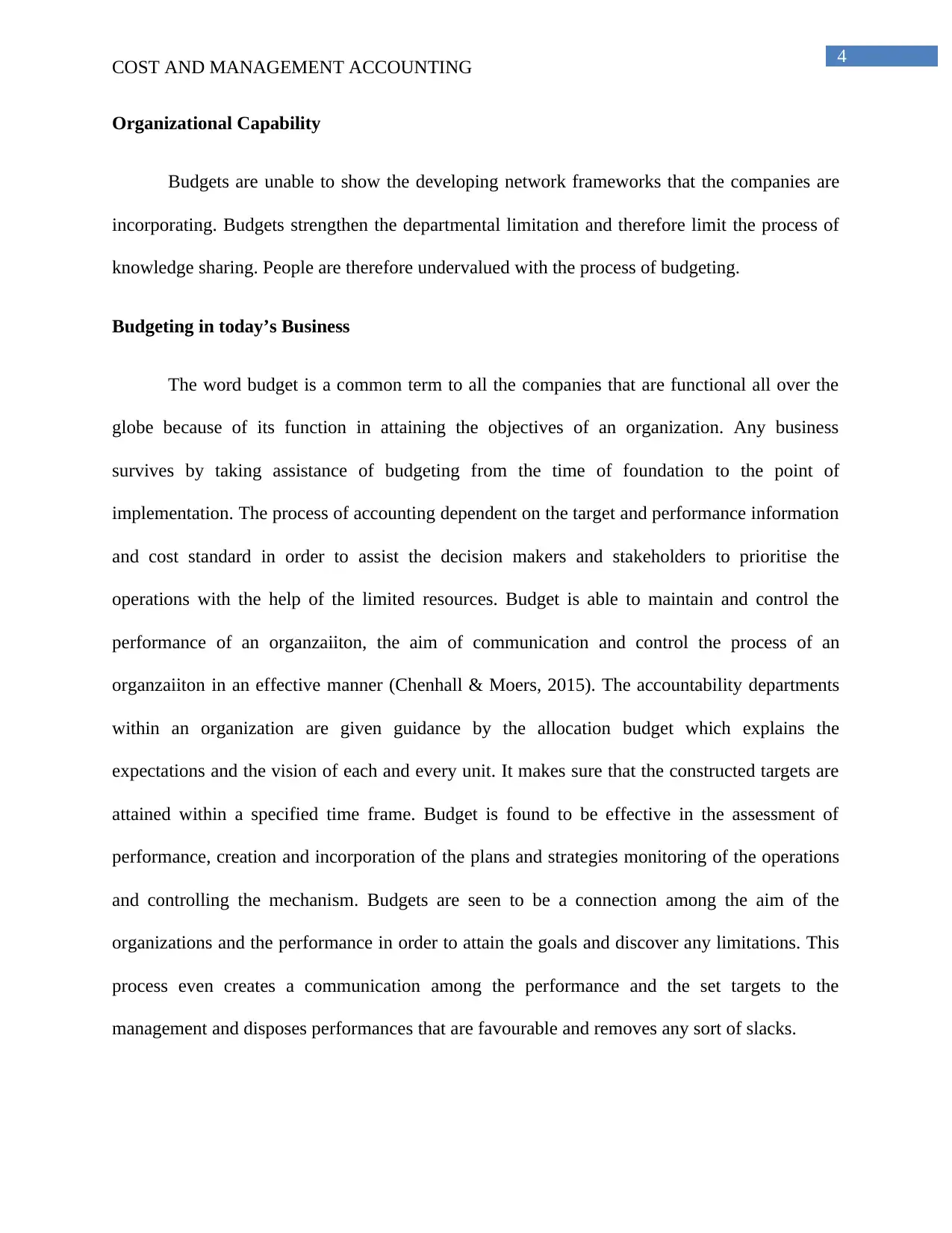
4
COST AND MANAGEMENT ACCOUNTING
Organizational Capability
Budgets are unable to show the developing network frameworks that the companies are
incorporating. Budgets strengthen the departmental limitation and therefore limit the process of
knowledge sharing. People are therefore undervalued with the process of budgeting.
Budgeting in today’s Business
The word budget is a common term to all the companies that are functional all over the
globe because of its function in attaining the objectives of an organization. Any business
survives by taking assistance of budgeting from the time of foundation to the point of
implementation. The process of accounting dependent on the target and performance information
and cost standard in order to assist the decision makers and stakeholders to prioritise the
operations with the help of the limited resources. Budget is able to maintain and control the
performance of an organzaiiton, the aim of communication and control the process of an
organzaiiton in an effective manner (Chenhall & Moers, 2015). The accountability departments
within an organization are given guidance by the allocation budget which explains the
expectations and the vision of each and every unit. It makes sure that the constructed targets are
attained within a specified time frame. Budget is found to be effective in the assessment of
performance, creation and incorporation of the plans and strategies monitoring of the operations
and controlling the mechanism. Budgets are seen to be a connection among the aim of the
organizations and the performance in order to attain the goals and discover any limitations. This
process even creates a communication among the performance and the set targets to the
management and disposes performances that are favourable and removes any sort of slacks.
COST AND MANAGEMENT ACCOUNTING
Organizational Capability
Budgets are unable to show the developing network frameworks that the companies are
incorporating. Budgets strengthen the departmental limitation and therefore limit the process of
knowledge sharing. People are therefore undervalued with the process of budgeting.
Budgeting in today’s Business
The word budget is a common term to all the companies that are functional all over the
globe because of its function in attaining the objectives of an organization. Any business
survives by taking assistance of budgeting from the time of foundation to the point of
implementation. The process of accounting dependent on the target and performance information
and cost standard in order to assist the decision makers and stakeholders to prioritise the
operations with the help of the limited resources. Budget is able to maintain and control the
performance of an organzaiiton, the aim of communication and control the process of an
organzaiiton in an effective manner (Chenhall & Moers, 2015). The accountability departments
within an organization are given guidance by the allocation budget which explains the
expectations and the vision of each and every unit. It makes sure that the constructed targets are
attained within a specified time frame. Budget is found to be effective in the assessment of
performance, creation and incorporation of the plans and strategies monitoring of the operations
and controlling the mechanism. Budgets are seen to be a connection among the aim of the
organizations and the performance in order to attain the goals and discover any limitations. This
process even creates a communication among the performance and the set targets to the
management and disposes performances that are favourable and removes any sort of slacks.

5
COST AND MANAGEMENT ACCOUNTING
Significance of Traditional Budgeting
The process of budget is a mechanism of communication among the departments and the
management with the help of which the cost and the profits for the coming years are planned.
There are three stages in the process of budgeting as cited by Becker et al., (2016) and they are
follow up, development and assessment. Oldman & Tomkins, (2018) explained that the
establishment of any sort of budget is the forecast of the coming revenues and expenses and
Nimtrakoon & Tayles, (2015) debated that it is the statistics of sales, which is the formation of
the budget. The creation of budget is known as the stage of development of any sort of budget
process within a company. The next stage is known as the follow up of the budget and this is the
assessment that makes a comparison about what had been budgeted with the real outcome and
the last stage of the assessment which provides an opportunity and idea to the company in order
to profit from the performance of the budget in the coming years. Appelbaum et al., (2017)
recommends that budget is utilised in order to bring out the external and internal influences
within a company. It generates a space for enhanced performance among the employees and
generates a productive ground for the process of making speedy decisions within an enterprise. It
is seen that most of the companies look at budgeting to be a benefit against the negative words
that are used by other stakeholders about the company. The ones who have supported the
sustained utilization of traditional budgeting have debated that their advantages are more than the
problems. Cohen & Karatzimas, (2015) discovered four key reasons for the process of budgeting
and they are grouped as performance and planning, which are short term and are functional in
nature and the other is creation of strategy and communication, which is a long term strategy.
COST AND MANAGEMENT ACCOUNTING
Significance of Traditional Budgeting
The process of budget is a mechanism of communication among the departments and the
management with the help of which the cost and the profits for the coming years are planned.
There are three stages in the process of budgeting as cited by Becker et al., (2016) and they are
follow up, development and assessment. Oldman & Tomkins, (2018) explained that the
establishment of any sort of budget is the forecast of the coming revenues and expenses and
Nimtrakoon & Tayles, (2015) debated that it is the statistics of sales, which is the formation of
the budget. The creation of budget is known as the stage of development of any sort of budget
process within a company. The next stage is known as the follow up of the budget and this is the
assessment that makes a comparison about what had been budgeted with the real outcome and
the last stage of the assessment which provides an opportunity and idea to the company in order
to profit from the performance of the budget in the coming years. Appelbaum et al., (2017)
recommends that budget is utilised in order to bring out the external and internal influences
within a company. It generates a space for enhanced performance among the employees and
generates a productive ground for the process of making speedy decisions within an enterprise. It
is seen that most of the companies look at budgeting to be a benefit against the negative words
that are used by other stakeholders about the company. The ones who have supported the
sustained utilization of traditional budgeting have debated that their advantages are more than the
problems. Cohen & Karatzimas, (2015) discovered four key reasons for the process of budgeting
and they are grouped as performance and planning, which are short term and are functional in
nature and the other is creation of strategy and communication, which is a long term strategy.
⊘ This is a preview!⊘
Do you want full access?
Subscribe today to unlock all pages.

Trusted by 1+ million students worldwide
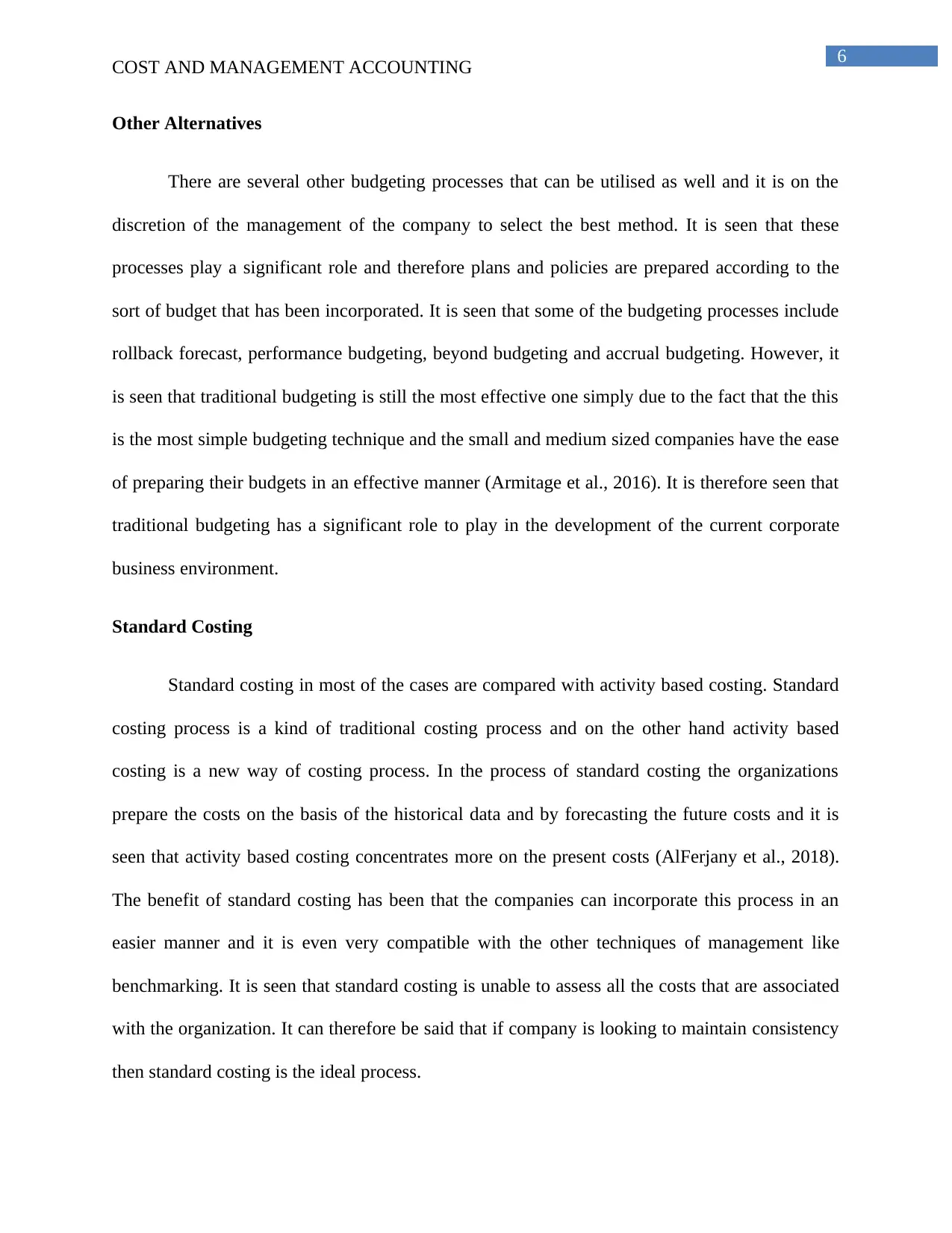
6
COST AND MANAGEMENT ACCOUNTING
Other Alternatives
There are several other budgeting processes that can be utilised as well and it is on the
discretion of the management of the company to select the best method. It is seen that these
processes play a significant role and therefore plans and policies are prepared according to the
sort of budget that has been incorporated. It is seen that some of the budgeting processes include
rollback forecast, performance budgeting, beyond budgeting and accrual budgeting. However, it
is seen that traditional budgeting is still the most effective one simply due to the fact that the this
is the most simple budgeting technique and the small and medium sized companies have the ease
of preparing their budgets in an effective manner (Armitage et al., 2016). It is therefore seen that
traditional budgeting has a significant role to play in the development of the current corporate
business environment.
Standard Costing
Standard costing in most of the cases are compared with activity based costing. Standard
costing process is a kind of traditional costing process and on the other hand activity based
costing is a new way of costing process. In the process of standard costing the organizations
prepare the costs on the basis of the historical data and by forecasting the future costs and it is
seen that activity based costing concentrates more on the present costs (AlFerjany et al., 2018).
The benefit of standard costing has been that the companies can incorporate this process in an
easier manner and it is even very compatible with the other techniques of management like
benchmarking. It is seen that standard costing is unable to assess all the costs that are associated
with the organization. It can therefore be said that if company is looking to maintain consistency
then standard costing is the ideal process.
COST AND MANAGEMENT ACCOUNTING
Other Alternatives
There are several other budgeting processes that can be utilised as well and it is on the
discretion of the management of the company to select the best method. It is seen that these
processes play a significant role and therefore plans and policies are prepared according to the
sort of budget that has been incorporated. It is seen that some of the budgeting processes include
rollback forecast, performance budgeting, beyond budgeting and accrual budgeting. However, it
is seen that traditional budgeting is still the most effective one simply due to the fact that the this
is the most simple budgeting technique and the small and medium sized companies have the ease
of preparing their budgets in an effective manner (Armitage et al., 2016). It is therefore seen that
traditional budgeting has a significant role to play in the development of the current corporate
business environment.
Standard Costing
Standard costing in most of the cases are compared with activity based costing. Standard
costing process is a kind of traditional costing process and on the other hand activity based
costing is a new way of costing process. In the process of standard costing the organizations
prepare the costs on the basis of the historical data and by forecasting the future costs and it is
seen that activity based costing concentrates more on the present costs (AlFerjany et al., 2018).
The benefit of standard costing has been that the companies can incorporate this process in an
easier manner and it is even very compatible with the other techniques of management like
benchmarking. It is seen that standard costing is unable to assess all the costs that are associated
with the organization. It can therefore be said that if company is looking to maintain consistency
then standard costing is the ideal process.
Paraphrase This Document
Need a fresh take? Get an instant paraphrase of this document with our AI Paraphraser
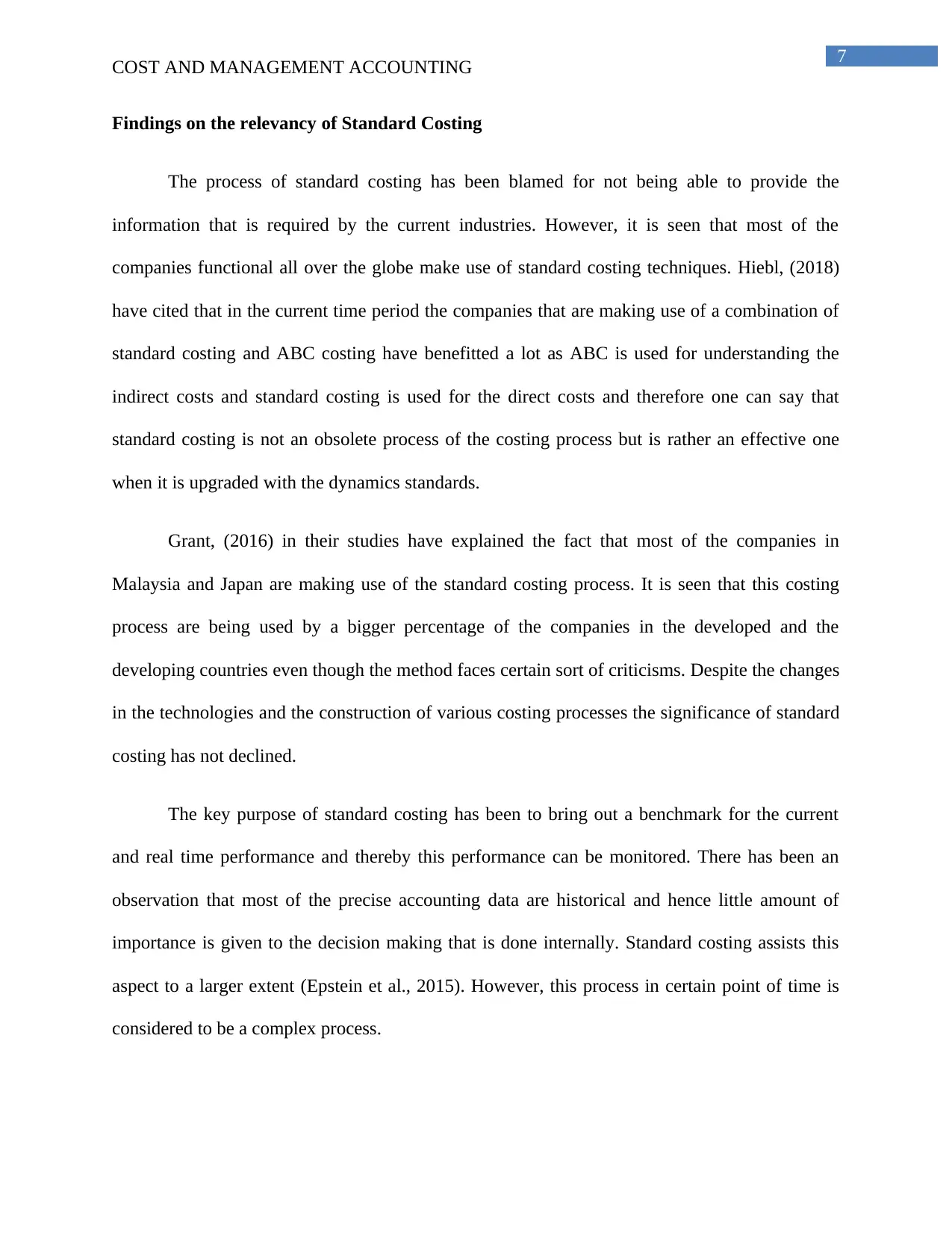
7
COST AND MANAGEMENT ACCOUNTING
Findings on the relevancy of Standard Costing
The process of standard costing has been blamed for not being able to provide the
information that is required by the current industries. However, it is seen that most of the
companies functional all over the globe make use of standard costing techniques. Hiebl, (2018)
have cited that in the current time period the companies that are making use of a combination of
standard costing and ABC costing have benefitted a lot as ABC is used for understanding the
indirect costs and standard costing is used for the direct costs and therefore one can say that
standard costing is not an obsolete process of the costing process but is rather an effective one
when it is upgraded with the dynamics standards.
Grant, (2016) in their studies have explained the fact that most of the companies in
Malaysia and Japan are making use of the standard costing process. It is seen that this costing
process are being used by a bigger percentage of the companies in the developed and the
developing countries even though the method faces certain sort of criticisms. Despite the changes
in the technologies and the construction of various costing processes the significance of standard
costing has not declined.
The key purpose of standard costing has been to bring out a benchmark for the current
and real time performance and thereby this performance can be monitored. There has been an
observation that most of the precise accounting data are historical and hence little amount of
importance is given to the decision making that is done internally. Standard costing assists this
aspect to a larger extent (Epstein et al., 2015). However, this process in certain point of time is
considered to be a complex process.
COST AND MANAGEMENT ACCOUNTING
Findings on the relevancy of Standard Costing
The process of standard costing has been blamed for not being able to provide the
information that is required by the current industries. However, it is seen that most of the
companies functional all over the globe make use of standard costing techniques. Hiebl, (2018)
have cited that in the current time period the companies that are making use of a combination of
standard costing and ABC costing have benefitted a lot as ABC is used for understanding the
indirect costs and standard costing is used for the direct costs and therefore one can say that
standard costing is not an obsolete process of the costing process but is rather an effective one
when it is upgraded with the dynamics standards.
Grant, (2016) in their studies have explained the fact that most of the companies in
Malaysia and Japan are making use of the standard costing process. It is seen that this costing
process are being used by a bigger percentage of the companies in the developed and the
developing countries even though the method faces certain sort of criticisms. Despite the changes
in the technologies and the construction of various costing processes the significance of standard
costing has not declined.
The key purpose of standard costing has been to bring out a benchmark for the current
and real time performance and thereby this performance can be monitored. There has been an
observation that most of the precise accounting data are historical and hence little amount of
importance is given to the decision making that is done internally. Standard costing assists this
aspect to a larger extent (Epstein et al., 2015). However, this process in certain point of time is
considered to be a complex process.
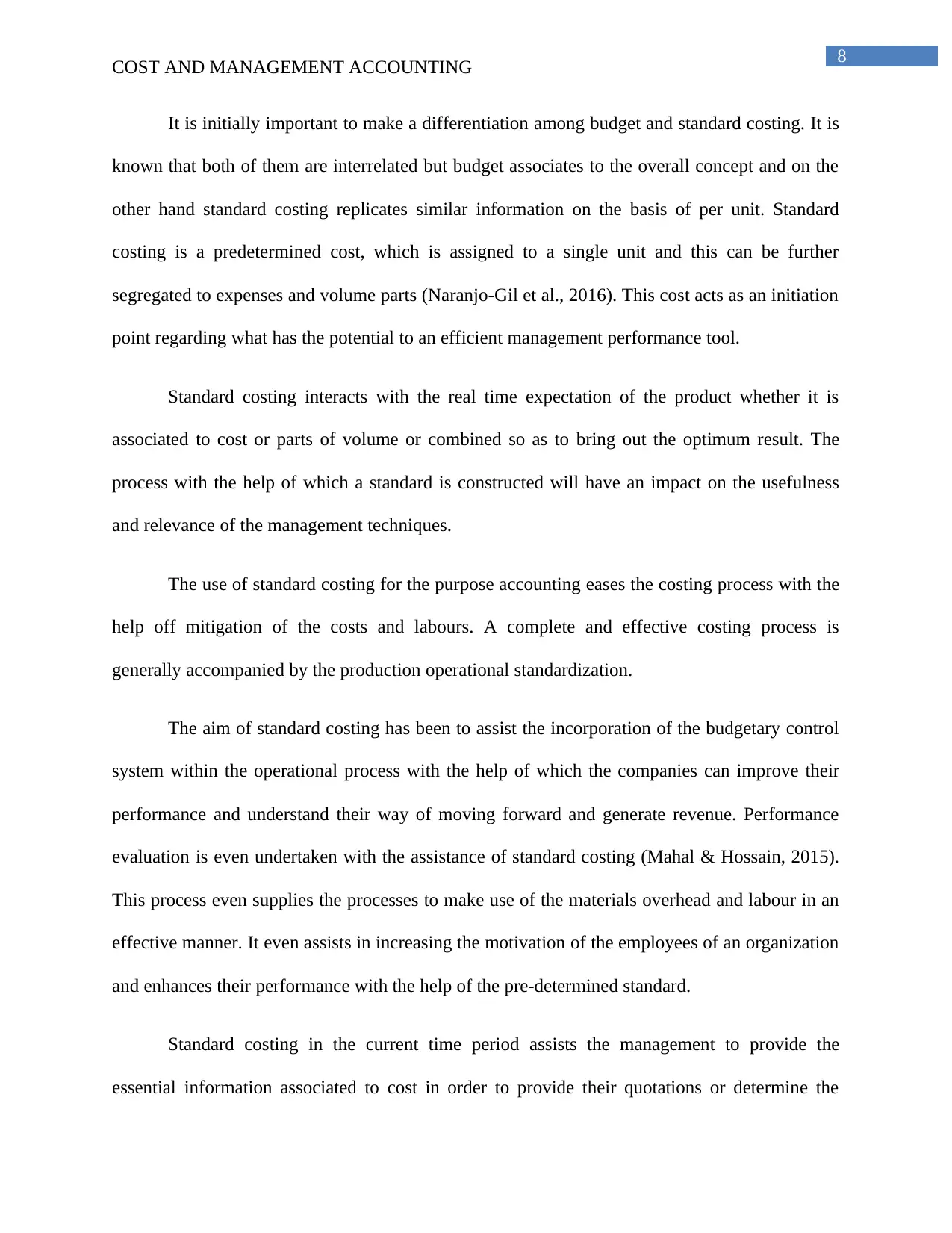
8
COST AND MANAGEMENT ACCOUNTING
It is initially important to make a differentiation among budget and standard costing. It is
known that both of them are interrelated but budget associates to the overall concept and on the
other hand standard costing replicates similar information on the basis of per unit. Standard
costing is a predetermined cost, which is assigned to a single unit and this can be further
segregated to expenses and volume parts (Naranjo-Gil et al., 2016). This cost acts as an initiation
point regarding what has the potential to an efficient management performance tool.
Standard costing interacts with the real time expectation of the product whether it is
associated to cost or parts of volume or combined so as to bring out the optimum result. The
process with the help of which a standard is constructed will have an impact on the usefulness
and relevance of the management techniques.
The use of standard costing for the purpose accounting eases the costing process with the
help off mitigation of the costs and labours. A complete and effective costing process is
generally accompanied by the production operational standardization.
The aim of standard costing has been to assist the incorporation of the budgetary control
system within the operational process with the help of which the companies can improve their
performance and understand their way of moving forward and generate revenue. Performance
evaluation is even undertaken with the assistance of standard costing (Mahal & Hossain, 2015).
This process even supplies the processes to make use of the materials overhead and labour in an
effective manner. It even assists in increasing the motivation of the employees of an organization
and enhances their performance with the help of the pre-determined standard.
Standard costing in the current time period assists the management to provide the
essential information associated to cost in order to provide their quotations or determine the
COST AND MANAGEMENT ACCOUNTING
It is initially important to make a differentiation among budget and standard costing. It is
known that both of them are interrelated but budget associates to the overall concept and on the
other hand standard costing replicates similar information on the basis of per unit. Standard
costing is a predetermined cost, which is assigned to a single unit and this can be further
segregated to expenses and volume parts (Naranjo-Gil et al., 2016). This cost acts as an initiation
point regarding what has the potential to an efficient management performance tool.
Standard costing interacts with the real time expectation of the product whether it is
associated to cost or parts of volume or combined so as to bring out the optimum result. The
process with the help of which a standard is constructed will have an impact on the usefulness
and relevance of the management techniques.
The use of standard costing for the purpose accounting eases the costing process with the
help off mitigation of the costs and labours. A complete and effective costing process is
generally accompanied by the production operational standardization.
The aim of standard costing has been to assist the incorporation of the budgetary control
system within the operational process with the help of which the companies can improve their
performance and understand their way of moving forward and generate revenue. Performance
evaluation is even undertaken with the assistance of standard costing (Mahal & Hossain, 2015).
This process even supplies the processes to make use of the materials overhead and labour in an
effective manner. It even assists in increasing the motivation of the employees of an organization
and enhances their performance with the help of the pre-determined standard.
Standard costing in the current time period assists the management to provide the
essential information associated to cost in order to provide their quotations or determine the
⊘ This is a preview!⊘
Do you want full access?
Subscribe today to unlock all pages.

Trusted by 1+ million students worldwide
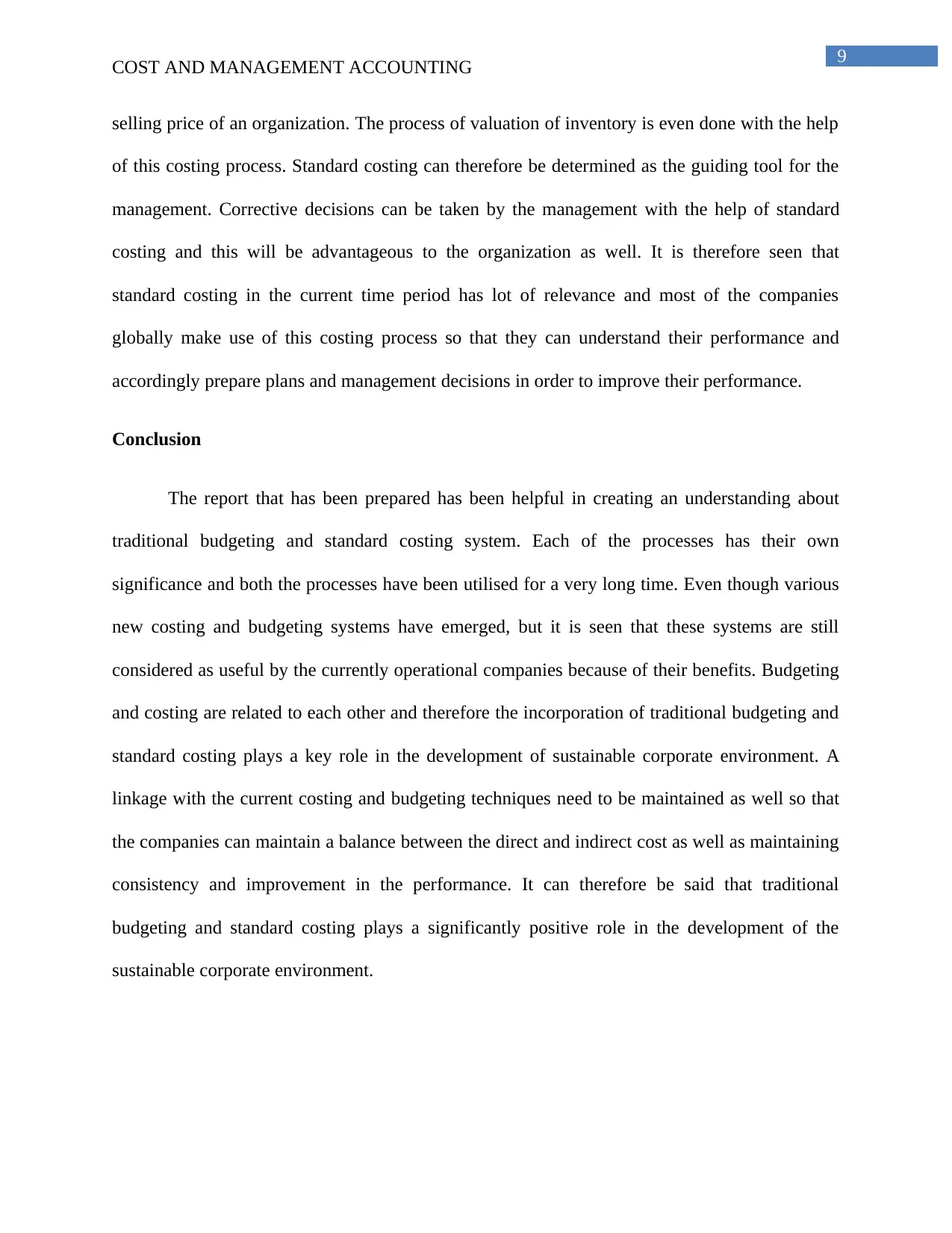
9
COST AND MANAGEMENT ACCOUNTING
selling price of an organization. The process of valuation of inventory is even done with the help
of this costing process. Standard costing can therefore be determined as the guiding tool for the
management. Corrective decisions can be taken by the management with the help of standard
costing and this will be advantageous to the organization as well. It is therefore seen that
standard costing in the current time period has lot of relevance and most of the companies
globally make use of this costing process so that they can understand their performance and
accordingly prepare plans and management decisions in order to improve their performance.
Conclusion
The report that has been prepared has been helpful in creating an understanding about
traditional budgeting and standard costing system. Each of the processes has their own
significance and both the processes have been utilised for a very long time. Even though various
new costing and budgeting systems have emerged, but it is seen that these systems are still
considered as useful by the currently operational companies because of their benefits. Budgeting
and costing are related to each other and therefore the incorporation of traditional budgeting and
standard costing plays a key role in the development of sustainable corporate environment. A
linkage with the current costing and budgeting techniques need to be maintained as well so that
the companies can maintain a balance between the direct and indirect cost as well as maintaining
consistency and improvement in the performance. It can therefore be said that traditional
budgeting and standard costing plays a significantly positive role in the development of the
sustainable corporate environment.
COST AND MANAGEMENT ACCOUNTING
selling price of an organization. The process of valuation of inventory is even done with the help
of this costing process. Standard costing can therefore be determined as the guiding tool for the
management. Corrective decisions can be taken by the management with the help of standard
costing and this will be advantageous to the organization as well. It is therefore seen that
standard costing in the current time period has lot of relevance and most of the companies
globally make use of this costing process so that they can understand their performance and
accordingly prepare plans and management decisions in order to improve their performance.
Conclusion
The report that has been prepared has been helpful in creating an understanding about
traditional budgeting and standard costing system. Each of the processes has their own
significance and both the processes have been utilised for a very long time. Even though various
new costing and budgeting systems have emerged, but it is seen that these systems are still
considered as useful by the currently operational companies because of their benefits. Budgeting
and costing are related to each other and therefore the incorporation of traditional budgeting and
standard costing plays a key role in the development of sustainable corporate environment. A
linkage with the current costing and budgeting techniques need to be maintained as well so that
the companies can maintain a balance between the direct and indirect cost as well as maintaining
consistency and improvement in the performance. It can therefore be said that traditional
budgeting and standard costing plays a significantly positive role in the development of the
sustainable corporate environment.
Paraphrase This Document
Need a fresh take? Get an instant paraphrase of this document with our AI Paraphraser
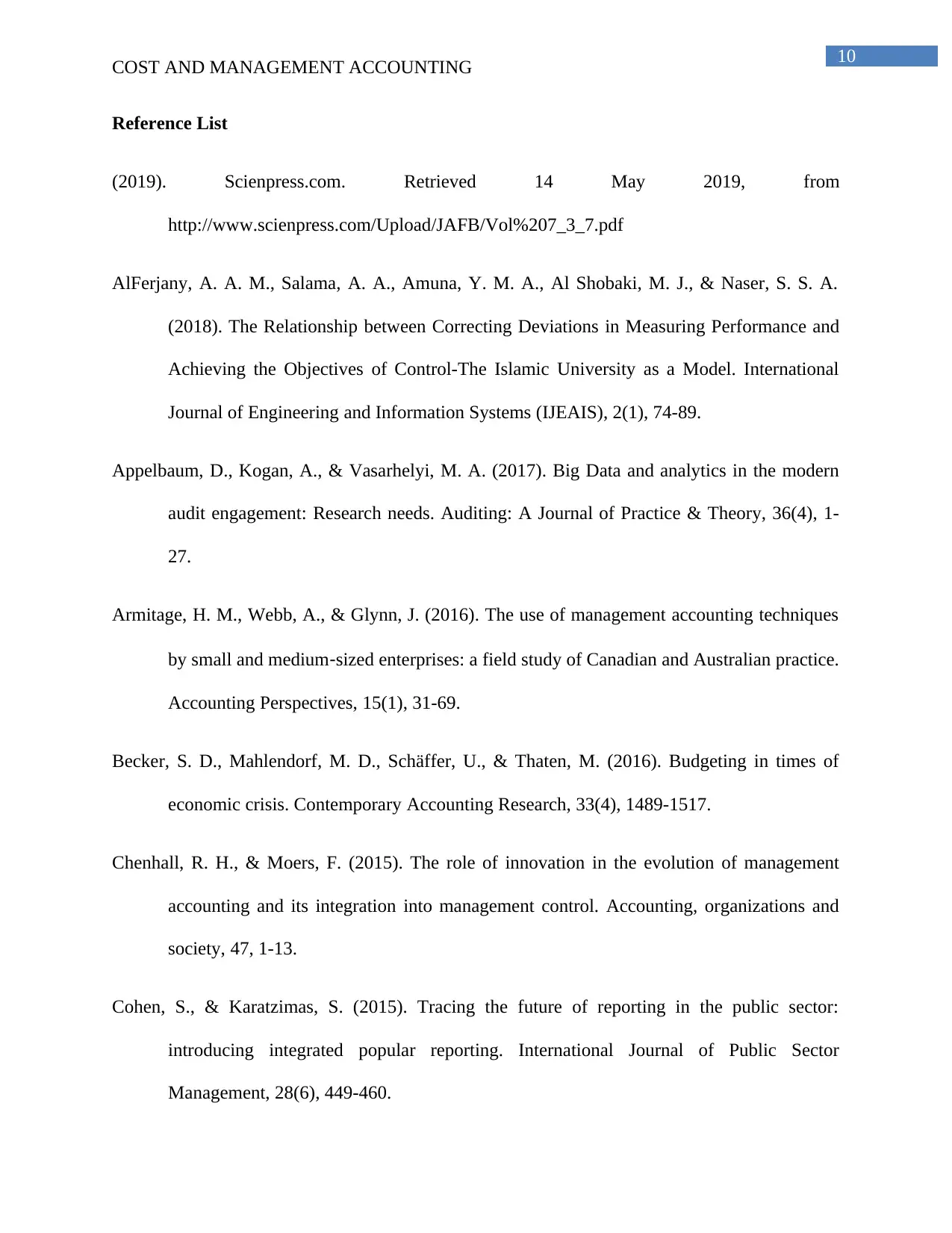
10
COST AND MANAGEMENT ACCOUNTING
Reference List
(2019). Scienpress.com. Retrieved 14 May 2019, from
http://www.scienpress.com/Upload/JAFB/Vol%207_3_7.pdf
AlFerjany, A. A. M., Salama, A. A., Amuna, Y. M. A., Al Shobaki, M. J., & Naser, S. S. A.
(2018). The Relationship between Correcting Deviations in Measuring Performance and
Achieving the Objectives of Control-The Islamic University as a Model. International
Journal of Engineering and Information Systems (IJEAIS), 2(1), 74-89.
Appelbaum, D., Kogan, A., & Vasarhelyi, M. A. (2017). Big Data and analytics in the modern
audit engagement: Research needs. Auditing: A Journal of Practice & Theory, 36(4), 1-
27.
Armitage, H. M., Webb, A., & Glynn, J. (2016). The use of management accounting techniques
by small and medium‐sized enterprises: a field study of Canadian and Australian practice.
Accounting Perspectives, 15(1), 31-69.
Becker, S. D., Mahlendorf, M. D., Schäffer, U., & Thaten, M. (2016). Budgeting in times of
economic crisis. Contemporary Accounting Research, 33(4), 1489-1517.
Chenhall, R. H., & Moers, F. (2015). The role of innovation in the evolution of management
accounting and its integration into management control. Accounting, organizations and
society, 47, 1-13.
Cohen, S., & Karatzimas, S. (2015). Tracing the future of reporting in the public sector:
introducing integrated popular reporting. International Journal of Public Sector
Management, 28(6), 449-460.
COST AND MANAGEMENT ACCOUNTING
Reference List
(2019). Scienpress.com. Retrieved 14 May 2019, from
http://www.scienpress.com/Upload/JAFB/Vol%207_3_7.pdf
AlFerjany, A. A. M., Salama, A. A., Amuna, Y. M. A., Al Shobaki, M. J., & Naser, S. S. A.
(2018). The Relationship between Correcting Deviations in Measuring Performance and
Achieving the Objectives of Control-The Islamic University as a Model. International
Journal of Engineering and Information Systems (IJEAIS), 2(1), 74-89.
Appelbaum, D., Kogan, A., & Vasarhelyi, M. A. (2017). Big Data and analytics in the modern
audit engagement: Research needs. Auditing: A Journal of Practice & Theory, 36(4), 1-
27.
Armitage, H. M., Webb, A., & Glynn, J. (2016). The use of management accounting techniques
by small and medium‐sized enterprises: a field study of Canadian and Australian practice.
Accounting Perspectives, 15(1), 31-69.
Becker, S. D., Mahlendorf, M. D., Schäffer, U., & Thaten, M. (2016). Budgeting in times of
economic crisis. Contemporary Accounting Research, 33(4), 1489-1517.
Chenhall, R. H., & Moers, F. (2015). The role of innovation in the evolution of management
accounting and its integration into management control. Accounting, organizations and
society, 47, 1-13.
Cohen, S., & Karatzimas, S. (2015). Tracing the future of reporting in the public sector:
introducing integrated popular reporting. International Journal of Public Sector
Management, 28(6), 449-460.

11
COST AND MANAGEMENT ACCOUNTING
Epstein, M. J., Buhovac, A. R., & Yuthas, K. (2015). Managing social, environmental and
financial performance simultaneously. Long range planning, 48(1), 35-45.
Grant, R. M. (2016). Contemporary strategy analysis: Text and cases edition. John Wiley &
Sons.
Hiebl, M. R. (2018). Management accounting as a political resource for enabling embedded
agency. Management Accounting Research, 38, 22-38.
Hope, J., & Fraser, R. (2003). New ways of setting rewards: The beyond budgeting model.
California Management Review, 45(4), 104-119.
Jensen, M. C. (2001). Corporate budgeting is broken, let's fix it. Harvard Business Review, 94-
101.
Mahal, I., & Hossain, A. (2015). Activity-Based Costing (ABC)–An Effective Tool for Better
Management. Research Journal of Finance and Accounting, 6(4), 66-74.
Naranjo-Gil, D., Sánchez-Expósito, M., & Gómez-Ruiz, L. (2016). Traditional vs. Contemporary
management control practices for developing public health policies. International journal
of environmental research and public health, 13(7), 713.
Nimtrakoon, S., & Tayles, M. (2015). Explaining management accounting practices and strategy
in Thailand: A selection approach using cluster analysis. Journal of Accounting in
Emerging Economies, 5(3), 269-298.
Nuhu, N. A., Baird, K., & Appuhami, R. (2016). The association between the use of
management accounting practices with organizational change and organizational
COST AND MANAGEMENT ACCOUNTING
Epstein, M. J., Buhovac, A. R., & Yuthas, K. (2015). Managing social, environmental and
financial performance simultaneously. Long range planning, 48(1), 35-45.
Grant, R. M. (2016). Contemporary strategy analysis: Text and cases edition. John Wiley &
Sons.
Hiebl, M. R. (2018). Management accounting as a political resource for enabling embedded
agency. Management Accounting Research, 38, 22-38.
Hope, J., & Fraser, R. (2003). New ways of setting rewards: The beyond budgeting model.
California Management Review, 45(4), 104-119.
Jensen, M. C. (2001). Corporate budgeting is broken, let's fix it. Harvard Business Review, 94-
101.
Mahal, I., & Hossain, A. (2015). Activity-Based Costing (ABC)–An Effective Tool for Better
Management. Research Journal of Finance and Accounting, 6(4), 66-74.
Naranjo-Gil, D., Sánchez-Expósito, M., & Gómez-Ruiz, L. (2016). Traditional vs. Contemporary
management control practices for developing public health policies. International journal
of environmental research and public health, 13(7), 713.
Nimtrakoon, S., & Tayles, M. (2015). Explaining management accounting practices and strategy
in Thailand: A selection approach using cluster analysis. Journal of Accounting in
Emerging Economies, 5(3), 269-298.
Nuhu, N. A., Baird, K., & Appuhami, R. (2016). The association between the use of
management accounting practices with organizational change and organizational
⊘ This is a preview!⊘
Do you want full access?
Subscribe today to unlock all pages.

Trusted by 1+ million students worldwide
1 out of 13
Related Documents
Your All-in-One AI-Powered Toolkit for Academic Success.
+13062052269
info@desklib.com
Available 24*7 on WhatsApp / Email
![[object Object]](/_next/static/media/star-bottom.7253800d.svg)
Unlock your academic potential
Copyright © 2020–2025 A2Z Services. All Rights Reserved. Developed and managed by ZUCOL.





